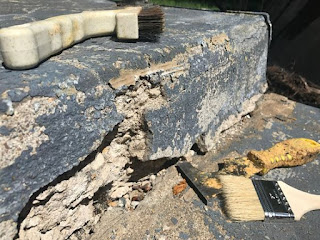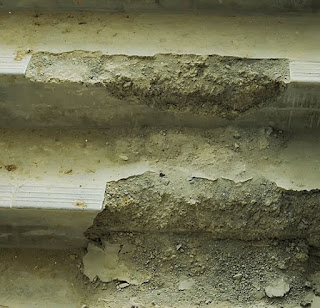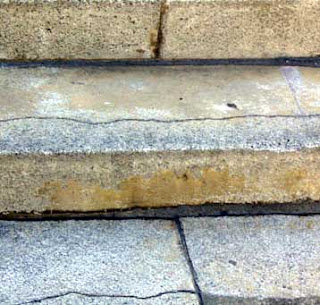Search This Blog
Most Popular
What is Development Length (Ld) in Construction?
August 14, 2025
Categories
- Building Construction (87)
- Building Materials (85)
- Columns (2)
- Concrete Beam (3)
- Concrete Construction Techniques (6)
- Concrete Mix Design (14)
- Concrete Repair (14)
- Concrete Slab (11)
- Construction Equipment (17)
- Construction News (7)
- Design of Structures (18)
- Engineering Drawing (1)
- Estimation (3)
- Geotechnical engineering (26)
- Highway Engineering (11)
- Innovations (34)
- Material Testing (11)
- Matrix Analysis of Structures (2)
- Mechanical Engineering (3)
- Strength of Materials (2)
- Structural Analysis (13)
- Structural Design (24)
- Structures (17)
- Transportation Engineering (9)
How to Repair Concrete Steps?
Team Prodyogi
April 11, 2023
Concrete steps are an integral part of many buildings and structures, providing a sturdy and durable surface for foot traffic and ensuring safe passage between different levels. However, over time, R.C.C (Reinforced Cement Concrete) concrete steps may suffer from damage or wear and tear, requiring repair to maintain their functionality and appearance.
Concrete steps can undergo surface cracks, spalling, erosion, stains or discoloration, and scaling. Each issue is dealt with different repair materials and procedures.
In this article, we will explore how to repair concrete steps subjected to various defects.
What Steps Cannot Be Repaired?
It's important to note that not all R.C.C. concrete steps can be repaired. In cases where the damage is severe or the structure is compromised, it may be necessary to replace the entire staircase. If you notice any of the following signs, it's best to contact a professional for further inspection:- Extensive cracking or chipping
- Structural damage or movement
- Complete Spalling (flaking or breaking off of the concrete surface)
- Corrosion of the reinforcing steel
Concrete Steps Repair Procedure
Before beginning the repair, assess the damage to the R.C.C. concrete steps. Mostly it can be surface cracks, spalling, erosion, stains or discoloration, and scaling. Also identify any underlying causes of the damage, such as water damage, soil erosion, or heavy use.
Now that we have identified the defect, let's dive into the repair process for each issue.
Surface Cracks
Hairline cracks on the surface of the concrete can be repaired with a concrete patching compound or hydraulic cement.
Repairing surface cracks on concrete steps is a relatively simple process that can be done using a few basic tools and materials. Here's a step-by-step guide on how to repair surface cracks on concrete steps:
- Clean the surface of the concrete steps thoroughly using a wire brush to remove any loose concrete debris or dirt. Use a damp cloth to wipe down the steps once done.
- Mix the concrete patching compound according to the instructions on the package. Typically, you'll need to add water and stir until the mixture has a smooth consistency.
- Apply a thin layer of the patching compound onto the crack using a putty knife. Make sure to push the compound deep into the crack.
- Wait for the patching compound to dry completely before applying a second layer. Repeat this process until the crack is filled and level with the surface of the steps.
- Use a trowel to smooth out the surface of the patching compound and blend it with the surrounding concrete surface.
- Let the patching compound dry completely as per the manufacturer's instructions.
Spalling or Chipping
This is when the concrete surface starts flaking or breaking off, usually due to exposure to freeze-thaw cycles or the use of deicing chemicals.
 |
Repairing spalling and edge chipping on concrete steps requires a few additional steps compared to repairing surface cracks. Here's a step-by-step guide on how to repair spalling and edge chipping on concrete steps:
- Start by cleaning the surface of the concrete steps using a wire brush to remove any loose concrete debris or dirt. Use a damp cloth to wipe down the steps once done.
- Mix the concrete resurfacer according to the instructions on the package. Typically, you'll need to add water and stir until the mixture has a smooth consistency.
- Apply a thin layer of the resurfacer onto the damaged areas of the steps using a trowel. Make sure to spread the resurfacer evenly and blend it with the surrounding concrete surface.
- Wait for the resurfacer to dry completely before applying a second layer if needed. Repeat this process until the damaged areas are level with the surface of the steps.
- Use a wire brush to roughen the surface of the resurfacer slightly.
- Apply a concrete bonding adhesive onto the roughened surface using a putty knife. This will help the concrete patching compound to adhere better to the surface.
- Mix the concrete patching compound according to the instructions on the package.
- Apply the patching compound onto the damaged areas using a putty knife. Make sure to push the compound deep into any cracks or chipped areas.
- Wait for the patching compound to dry completely before sanding down the surface to a smooth finish.
- Apply a concrete sealer to the repaired areas of the steps once they are fully dry as per the manufacturer's instructions.
- When the chipping is at the corner, you can seek the help of formwork to more perfect corners.
By following these steps, you should be able to repair spalling and edge chipping on your concrete steps, making them look as good as new.
Scaling on Concrete Steps
Scaling occurs when the top layer of the concrete starts to peel away, exposing the rough aggregate beneath. This can be repaired by removing the damaged concrete and applying a new layer of concrete.
- Clean the area: Before starting the repair process, clean the area thoroughly with a wire brush to remove any loose material or debris.
- Remove the loose concrete: Use a hammer and chisel to carefully remove any loose or flaking concrete from the affected area. Be sure to remove all of the loose concrete to prevent further scaling.
- Apply a bonding agent: To ensure the new concrete adheres properly to the old concrete, apply a bonding agent to the affected area using a brush.
- Apply a concrete patch: Mix the concrete patching compound according to the manufacturer's instructions, and then apply it to the affected area with a trowel. Make sure to press the patching compound firmly into the area, and then smooth it out so it is level with the surrounding surface.
- Texture the surface: To match the texture of the surrounding concrete, use a stiff-bristled brush or a trowel to create a texture on the patched area before the patching compound dries.
- Allow to dry: Allow the patching compound to dry completely according to the manufacturer's instructions. This may take several hours or even overnight.
- Seal: Once the patching compound is dry, apply a sealer to the repaired area to protect it from further scaling and damage. Apply the sealer according to the manufacturer's instructions.
Conclusion
Repairing R.C.C. concrete steps can be a challenging task, but with the right materials, tools, and equipment, it's possible to restore them to their former functionality and appearance. Remember to assess the damage, prepare the surface, mix the repair material, apply it, allow it to cure, and finish it with a sealer or waterproofing agent.If you are repairing the start, middle, or end sections, install formwork to hold the repair material in place. However, if the damage is severe, it's best to contact a professional to ensure your safety and the structural integrity of the steps.
Read More On: How to Repair Concrete Roof Leakage?
Most Visited
Soil Sampling Methods| Undisturbed and Disturbed Samples
November 08, 2023
Boring Methods for Soil Exploration
November 02, 2023
What are Infiltration Wells?
April 15, 2024
Steel Column Connected to Concrete Masonry Wall
October 11, 2017
How to Choose Good Quality Aggregates for Construction?
August 10, 2021
Terzaghi's Equation: Soil Bearing Capacity for Foundations
March 02, 2022
Structure of Timber |Macrostructure and Microstructure
March 22, 2024
Search This Blog
MUST READ
What is PERT? Objectives, Pros & Cons
September 10, 2017
Terzaghi's Equation: Soil Bearing Capacity for Foundations
March 02, 2022
Contact Form
Footer Menu Widget
Created By SoraTemplates | Distributed By Gooyaabi Templates




0 Comments
Commenting Spam Links Are Against Policies